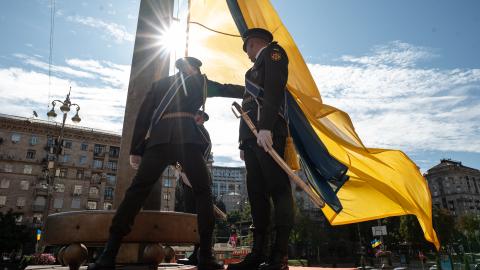Below Senior Fellow Can Kasapoğlu offers a military situation report about the war in Ukraine.
Executive Summary
• Ukraine is conducting information and political warfare to establish itself in the Russian region of Kursk.
• Russian forces are moving closer to capturing the critical city of Pokrovsk in eastern Ukraine.
• Ukraine struck the Marinovka Air Base in the Russian city of Volgograd and a ship in Port Kavkaz in occupied Crimea, showcasing the Ukrainian Armed Forces’ improving long-range strike deterrent.
1. Kursk Update: Ukraine Continues Offensive Actions inside Russia
The Ukrainian Armed Forces are consolidating their gains in the Russian region of Kursk and conducting stability operations designed to win the hearts and minds of the local population. To that end, Ukrainian servicemen are using social media to share pictures and videos documenting friendly exchanges with the people of Kursk, often while providing them humanitarian aid. This strategic use of social media is part of a broader information warfare effort that demonstrates Kyiv’s intention to govern the area until the end of the war and potentially use Russian territory as leverage in future negotiations.
Now that Ukrainian forces have settled into Kursk, previously undisclosed details of their initial push into the region are coming to light. Newly revealed information suggests that drone warfare battalions from the 14th Regiment of Ukraine’s Unmanned Systems Command were among the first units to enter Kursk. These elements have now established themselves in the basements of local buildings in Sudzha, though for operational security this report cannot disclose any geolocation data regarding Ukraine’s forward operating bases.
Visuals from the region indicate that the Ukrainian military’s air assault brigades are ambushing Russian convoys deep inside Kursk. Geospatial intelligence reveals Russian engineers’ ongoing efforts to build defensive architecture against Ukraine’s forces, including new trenches only six miles from the Kursk Nuclear Power Plant. United Kingdom Defence Intelligence notes that the Kremlin has deployed a special regiment of soldiers from the Russian Aerospace Forces (VKS) to aid its defensive efforts. The unit comprises critical personnel from long-range bomber bases and early warning radar operators. Whether these specially trained servicemen will be placed in dangerous line infantry roles remains to be seen.
Heavy urban warfare continues in Kursk. Open-source intelligence indicates that Russian troops have suffered casualties from at least one friendly fire incident. The quality of the Kremlin’s combat-deployed servicemen remains its most glaring weakness and contributes to the large number of prisoners of war that have been taken by Ukraine.
Russia has also allocated troops from southern Ukraine and the Kharkiv front to Kursk, though the Kremlin’s forces in eastern Ukraine remain formidable. Social media posts claim that Moscow has dispatched an elite formation, the 56th Guards Air Assault Regiment of the Russian Airborne Forces (VDV), to defend Kursk against the Ukrainian incursion.
Last week, the Ukrainian military conducted deep strikes on crossings along the Seym River in an effort to shape the battlefield. This has left Russian troops in the Glushkovsky District of Kursk trapped between the Seym River, the Ukraine-Russia border near Sumy, and Ukrainian troop formations.
Ukrainian units continued to hit the temporary pontoon bridges that Russian engineering units are constructing across the Seym. Evidence indicates that Ukraine has used cluster warhead–configuration rocket systems in some engagements. News outlets have even claimed that Ukrainian MiG-29 aircraft carrying French Hammer rocket-assisted glide bombs have flown sorties along the river. This development, if confirmed, suggests that Russia’s air defense envelopes in the region suffer from critical gaps.
2. Battlefield Assessment
On August 26, Russia launched massive waves of drones and missiles at multiple regions of Ukraine, including the city of Kyiv, marking the Kremlin’s most significant response to the Ukrainian offensive in Kursk thus far. Russia’s mixed strike packages used a combination of Kinzhal aeroballistic missiles and Iskander ballistic missiles, various kinds of air-launched cruise missiles, and more than 100 Iranian-origin Shahed-baseline loitering munitions. While Ukrainian air defenses managed to intercept the bulk of the salvo, breaches claimed the lives of many civilians.
The situation in eastern Ukraine, particularly in the cities of Pokrovsk and Toretsk, is precarious. Ukrainian combat formations have been forced to strategically withdraw from multiple locations to avoid encirclement. Kyiv has also ordered civilians to evacuate Pokrovsk because the important logistics hub is at risk of falling to the Russians. Control of the city would significantly strengthen the Russian military’s position, providing it with multiple possible axes of advance near Donetsk; Russia’s 90th Tank Division has already breached critical positions across the city’s outskirts.
In Kharkiv Ukraine is playing it safe, attempting to degrade the offensive capabilities of the invading Russian forces. Recently, Ukraine’s 3rd Separate Assault Brigade launched an offensive against formations of Russia’s 20th Combined Arms Army, attritting the latter’s offensive potential. The situation around Kharkiv is likely to remain static in the coming weeks.
Again this week, the Ukrainian military unleashed its improving long-range strike capabilities deep inside Russia. The most notable example was a strike on the Marinovka Air Base, a facility in Volgograd that hosts Russian bomber aircraft. The airfield is 560 miles inside Russia, which suggests that Kyiv’s long-range strike capabilities are becoming stronger.
Ukraine also attacked a roll-on/roll-off (RORO) ship carrying train cars and fuel tanks in Port Kavkaz, a small harbor in occupied Crimea. Reportedly, Ukraine targeted the ship with Neptune missiles, a weapon system famed for sinking the Russian Black Sea Fleet’s flagship missile cruiser, the Moskva. Available satellite imagery confirms severe damage to the RORO vessel and the port.
Finally, Ukraine has introduced a new part-missile and part-drone weapon system, the Palyanitsa. Future editions of this report will assess the technical details of this hybrid weapon.


















